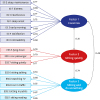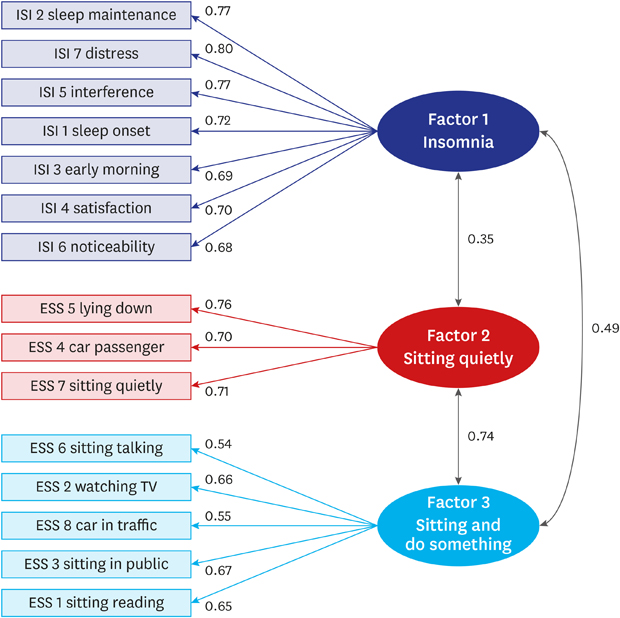1. Bae MJ, Song YM, Shin JY, Choi BY, Keum JH, Lee EA. the association between shift work and health behavior: findings from the Korean National Health and Nutrition Examination Survey. Korean J Fam Med. 2017; 38(2):86–92.
2. Gan Y, Yang C, Tong X, Sun H, Cong Y, Yin X, et al. Shift work and diabetes mellitus: a meta-analysis of observational studies. Occup Environ Med. 2015; 72(1):72–78.
3. Vyas MV, Garg AX, Iansavichus AV, Costella J, Donner A, Laugsand LE, et al. Shift work and vascular events: systematic review and meta-analysis. BMJ. 2012; 345:e4800.
4. Booker LA, Magee M, Rajaratnam SM, Sletten TL, Howard ME. Individual vulnerability to insomnia, excessive sleepiness and shift work disorder amongst healthcare shift workers. A systematic review. Sleep Med Rev. 2018; 41:220–233.
5. Sateia MJ. International classification of sleep disorders-third edition: highlights and modifications. Chest. 2014; 146(5):1387–1394.
6. Park H, Suh B, Lee SJ. Shift work and depressive symptoms: the mediating effect of vitamin D and sleep quality. Chronobiol Int. 2019; 36(5):689–697.
7. Dawson D, Ian Noy Y, Härmä M, Akerstedt T, Belenky G. Modelling fatigue and the use of fatigue models in work settings. Accid Anal Prev. 2011; 43(2):549–564.
8. Akerstedt T, Fredlund P, Gillberg M, Jansson B. A prospective study of fatal occupational accidents -- relationship to sleeping difficulties and occupational factors. J Sleep Res. 2002; 11(1):69–71.
9. Hale HB, Williams EW, Smith BN, Melton CE Jr. Neuroendocrine and metabolic responses to intermittent night shift work. Aerosp Med. 1971; 42(2):156–162.
10. National Institutes of Health. National Institutes of Health State of the Science Conference statement on manifestations and management of chronic insomnia in adults, June 13–15, 2005. Sleep. 2005; 28(9):1049–1057.
11. Bastien CH, Vallières A, Morin CM. Validation of the Insomnia Severity Index as an outcome measure for insomnia research. Sleep Med. 2001; 2(4):297–307.
12. Fernandez-Mendoza J, Rodriguez-Muñoz A, Vela-Bueno A, Olavarrieta-Bernardino S, Calhoun SL, Bixler EO, et al. The Spanish version of the Insomnia Severity Index: a confirmatory factor analysis. Sleep Med. 2012; 13(2):207–210.
13. Johns MW. A new method for measuring daytime sleepiness: the Epworth sleepiness scale. Sleep. 1991; 14(6):540–545.
14. Johns MW. A new perspective on sleepiness. Sleep Biol Rhythms. 2010; 8(3):170–179.
15. Sargento P, Perea V, Ladera V, Lopes P, Oliveira J. The Epworth Sleepiness Scale in Portuguese adults: from classical measurement theory to Rasch model analysis. Sleep Breath. 2015; 19(2):693–701.
16. Cho YW, Lee JH, Son HK, Lee SH, Shin C, Johns MW. The reliability and validity of the Korean version of the Epworth sleepiness scale. Sleep Breath. 2011; 15(3):377–384.
17. Savard MH, Savard J, Simard S, Ivers H. Empirical validation of the Insomnia Severity Index in cancer patients. Psychooncology. 2005; 14(6):429–441.
18. Sierra JC, Guillén-Serrano V, Santos-Iglesias P. Insomnia Severity Index: some indicators about its reliability and validity on an older adults sample. Rev Neurol. 2008; 47(11):566–570.
19. Gagnon C, Bélanger L, Ivers H, Morin CM. Validation of the Insomnia Severity Index in primary care. J Am Board Fam Med. 2013; 26(6):701–710.
20. Chiner E, Arriero JM, Signes-Costa J, Marco J, Fuentes I. Validation of the Spanish version of the Epworth sleepiness scale in patients with a sleep apnea syndrome. Arch Bronconeumol. 1999; 35(9):422–427.
21. Spira AP, Beaudreau SA, Stone KL, Kezirian EJ, Lui LY, Redline S, et al. Reliability and validity of the Pittsburgh sleep quality index and the Epworth sleepiness scale in older men. J Gerontol A Biol Sci Med Sci. 2012; 67(4):433–439.
22. Vallières A, Azaiez A, Moreau V, LeBlanc M, Morin CM. Insomnia in shift work. Sleep Med. 2014; 15(12):1440–1448.
24. Cho YW, Song ML, Morin CM. Validation of a Korean version of the insomnia severity index. J Clin Neurol. 2014; 10(3):210–215.
25. Hooper D, Coughlan J, Mullen M. Structural equation modelling: guidelines for determining model fit. J Bus Res Methods. 2008; 6(1):53–60.
26. Bastien CH, Vallières A, Morin CM. Validation of the Insomnia Severity Index as an outcome measure for insomnia research. Sleep Med. 2001; 2(4):297–307.
27. Johns MW. Reliability and factor analysis of the Epworth Sleepiness Scale. Sleep. 1992; 15(4):376–381.
28. Hair JF. Multivariate Data Analysis. 6th ed. New Delhi: Pearson Education;2009.
29. Choi CH, You YY. The study on comparative analysis of the same data through regression analysis model and structural equation model. J Digit Converg. 2016; 14(6):167–175.
30. Hong SW, Gong HS, Park JW, Roh YH, Baek GH. Validity, reliability and responsiveness of the Korean version of quick disabilities of the arm, shoulder, and hand questionnaire in patients with carpal tunnel syndrome. J Korean Med Sci. 2018; 33(40):e249.
31. Song M, Lee SH, Jahng S, Kim SY, Kang Y. Validation of the Korean-Everyday Cognition (K-ECog). J Korean Med Sci. 2019; 34(9):e67.
32. Sohn SI, Kim DH, Lee MY, Cho YW. The reliability and validity of the Korean version of the Pittsburgh Sleep Quality Index. Sleep Breath. 2012; 16(3):803–812.
33. Morin CM, Bélanger L, LeBlanc M, Ivers H, Savard J, Espie CA, et al. The natural history of insomnia: a population-based 3-year longitudinal study. Arch Intern Med. 2009; 169(5):447–453.
34. Chung KF, Kan KK, Yeung WF. Assessing insomnia in adolescents: comparison of insomnia severity index, Athens insomnia scale and sleep quality index. Sleep Med. 2011; 12(5):463–470.
35. Chen PY, Yang CM, Morin CM. Validating the cross-cultural factor structure and invariance property of the insomnia severity index: evidence based on ordinal EFA and CFA. Sleep Med. 2015; 16(5):598–603.
36. Gerber M, Lang C, Lemola S, Colledge F, Kalak N, Holsboer-Trachsler E, et al. Validation of the German version of the insomnia severity index in adolescents, young adults and adult workers: results from three cross-sectional studies. BMC Psychiatry. 2016; 16(1):174.
37. Vallières A, Azaiez A, Moreau V, LeBlanc M, Morin CM. Insomnia in shift work. Sleep Med. 2014; 15(12):1440–1448.
38. Chen NH, Johns MW, Li HY, Chu CC, Liang SC, Shu YH, et al. Validation of a Chinese version of the Epworth sleepiness scale. Qual Life Res. 2002; 11(8):817–821.
39. Johns MW. Sleepiness in different situations measured by the Epworth sleepiness scale. Sleep. 1994; 17(8):703–710.
40. Kingshott R, Douglas N, Deary I. Mokken scaling of the Epworth sleepiness scale items in patients with the sleep apnoea/hypopnoea syndrome. J Sleep Res. 1998; 7(4):293–294.
41. Johns MW. Reliability and factor analysis of the Epworth sleepiness scale. Sleep. 1992; 15(4):376–381.
42. Ohayon MM, Lemoine P, Arnaud-Briant V, Dreyfus M. Prevalence and consequences of sleep disorders in a shift worker population. J Psychosom Res. 2002; 53(1):577–583.
43. Pagel JF. Excessive daytime sleepiness. Am Fam Physician. 2009; 79(5):391–396.
44. Drake CL, Roehrs T, Richardson G, Walsh JK, Roth T. Shift work sleep disorder: prevalence and consequences beyond that of symptomatic day workers. Sleep. 2004; 27(8):1453–1462.
45. Suzuki K, Ohida T, Kaneita Y, Yokoyama E, Uchiyama M. Daytime sleepiness, sleep habits and occupational accidents among hospital nurses. J Adv Nurs. 2005; 52(4):445–453.
46. Lee K, Kim D, Cho Y. Exploratory factor analysis of the Beck anxiety inventory and the Beck depression inventory-II in a psychiatric outpatient population. J Korean Med Sci. 2018; 33(16):e128.











 PDF
PDF Citation
Citation Print
Print




 XML Download
XML Download